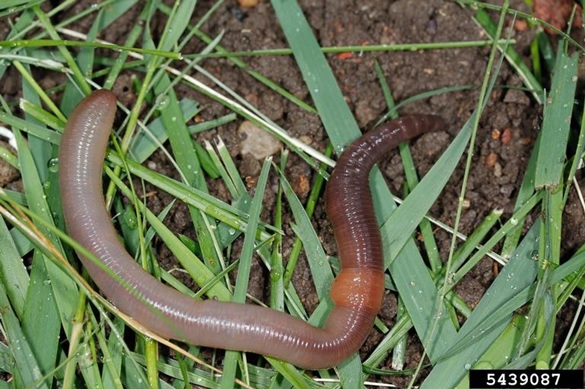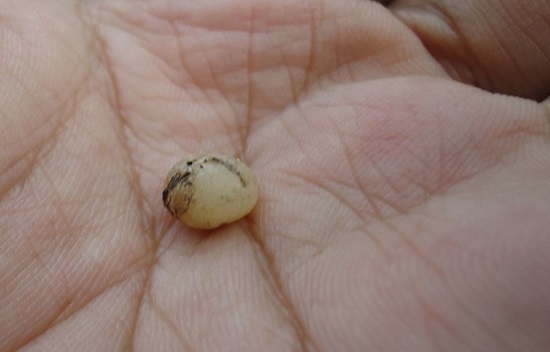Earthworms: Benefits and Potential Issues
ENTFACT-402: Earthworms: Benefits and Potential Issues | Download PDF
by jonathan l. Larson, Extension entomologist
University of Kentucky College of Agriculture
Fast Facts
- Earthworms are soil dwelling organisms that can have significant impacts on the fertility and utility of soil for plants.
- There are multiple species of earthworms that can be found in Kentucky soils, many of them are non-native, they can be found relatively high in the soil profile or as deep as six feet belowground.
- Earthworms are generally regarded as beneficial organisms, though they can sometimes damage plants or attract moles to an area.
Earthworm Description
Earthworms are segmented worms; their bodies are tubular, and they vary in color from red and pink to brown or khaki. Most species will also have a noticeable “clitellum”. These raised rings around the body are a part of the reproductive system and often are useful for identification purposes. Earthworms in Kentucky can vary in length from under an inch to 4-8 inches long. Worms can also squeeze their segments to alter their length and thickness to escape being captured.

Earthworms and Kentucky
Most of the earthworms encountered in Kentucky are introduced, non-native species. Many of them are originally from Europe and were introduced to the Americas during the colonization period. Areas in the northern United States that were once dominated by glacial sheets of ice did not have many or any earthworms and introduced species were able to quickly fill the worm vacuum.
Kentucky is home to European species such as nightcrawlers, red wigglers, and red earthworms. Asian species such as green stink worms and jumping worms have also been found here. Finally, there are native species as well, including the proudly named Kentucky earthworm.
Lifecycle
Generally, earthworms may live for one or two growing seasons, though some species may live four or more years. Earthworms produce an egg case, typically called a cocoon. They may overwinter in this stage but eggs can be produced anytime in the growing season.
When they first emerge, most species will be small and white. As they grow, they will get longer and take on a darker color. They won’t be mature until the clitellum forms. Once they are adults, earthworms can reproduce asexually or through mating.

Benefits of Earthworms
Earthworms are often considered beneficial organisms by the general public. As soil-dwelling decomposers, worms consume leaf litter, thatch, and other pieces of rotting organic matter. Some earthworms do this near the surface of the soil while others, such as nightcrawlers, will construct permanent tunnels deeper in the soil from which they will emerge to obtain food and pull it into their burrow.
Earthworms that create tunnels in the soil also contribute to soil health with their movements. Worm tunnels increase water infiltration of the soil as well as aerate. Overall, they may not directly benefit the soil but in certain situations can contribute to the health of soil ecosystems.
Many other animals may also use worms as a food item. In the complicated food webs found outside, earthworms may be eaten by birds, snakes, various mammals, and by many different types of insects and other invertebrates.
Potential Issues Associated with Worms
Earthworms can also pose problems because of their behavior. Some worms may produce “castings”, which are a muddy substance ejected from the body and made up of parts of the decomposing matter they have ingested. Casts may be produced near the surface of the soil, the muddy material can be flattened by foot traffic, killing small spots of turfgrass. Casts can also dull mower blades and may affect the playability of turf used for golfing.
In home lawns, there are occasional issues with nightcrawler middens. These earthworms live in deeper tunnels, they will emerge at night and pull leaves, twigs, and other detritus towards the entrance hole. What isn’t consumed can pile up and resemble a tent like structure above a central hole. Grass nearby might be killed or consumed, and the yard may take on a “lumpy” appearance.
Earthworms are one of the main prey items for moles. There is the possibility that high worm populations in a yard could lead to mole issues, though treating for earthworms is not a recommended control measure for the moles themselves.
Finally, some earthworms from Asia are more recent introductions into our ecosystems. Jumping worms in particular are a non-native species that is becoming truly invasive. In the Great Lakes region, these worms are invading forests and consuming so much of the decomposing material in the soil that they are altering the chemistry of the land. This in turn is affecting what trees can grow in the forest understory. These worms have been detected in Kentucky, though they have been more associated with lawns and backyard gardens. They can out compete other worms in the area and may cause the soil to change in texture. Jumping worm infested soil resembles spent coffee grounds and is less healthy for plants to grow in.
Management
There are no labeled pesticides currently available for worm control. As earthworms are widely considered beneficial, pesticides have been changed over time to have less of an impact on them. Legally, there can be no recommendation given to use a pesticide explicitly for treating earthworms.
Using cultural control methods, such as limiting irrigation to make a drier habitat, or mechanical methods of control, such as thatch raking, topdressing, or rolling the soil, may cause worm populations to decrease.
04/25 (Revised)
CAUTION! Pesticide recommendations in this publication are registered for use in Kentucky, USA ONLY! The use of some products may not be legal in your state or country. Please check with your local county agent or regulatory official before using any pesticide mentioned in this publication.
Of course, ALWAYS READ AND FOLLOW LABEL DIRECTIONS FOR SAFE USE OF ANY PESTICIDE!
Images: University of Kentucky Entomology unless otherwise indicated.
